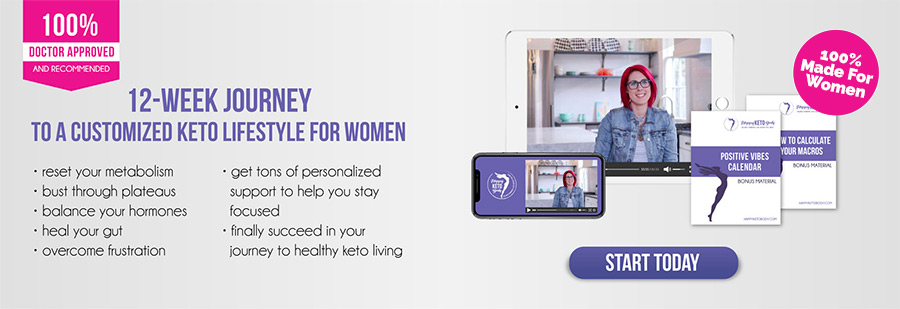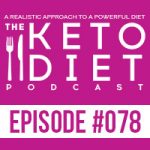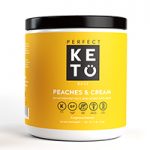I want...
Do Keto And Alcohol Mix?
May 13, 2018 By
Leanne Vogel

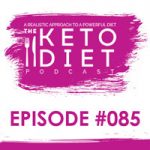 October 17, 2018
October 17, 2018
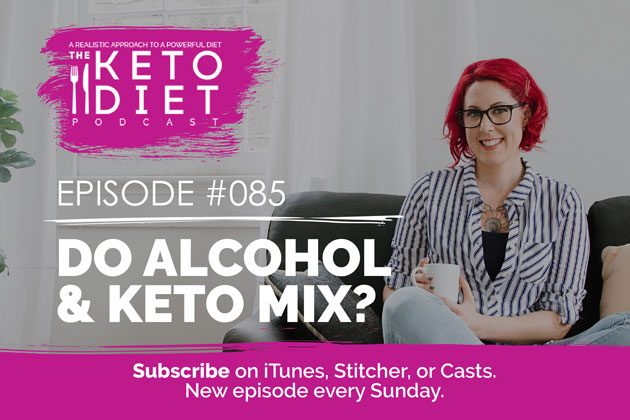
Interview with Todd White, chatting about the actual ingredients in wine, what to look for in a keto-friendly wine, what happens to your ketones after a glass (or 2) of wine, and so much more.
For podcast transcript, scroll down.
Show Notes + Links
- Freebie: 5 steps to overcoming carb cravings
- Subscribe on iTunes or your favorite podcast app
- RSVP for the 2018 Keto Diet Book Tour
Timestamps
- The actual ingredients in wine (aka TOXINS) (13:32)
- What to look for in a healthy, keto-friendly wine (21:45)
- What happens to your ketones after a glass (or 2) of wine (27:52)
Partners of The Keto Diet Podcast
- Instant 20% off your paleovalley order
- $20 off your first 3 Thrive Market orders of $49 or more, a total of $60 in savings
- Keto-friendly wines from Dry Farm Wines, straight to your doorstep. Listeners of the podcast can add an extra bottle of wine to your first order for just 1 penny.
Transcript for This Episode
Leanne Vogel: You’re listening to Episode Number 85 of The Keto Diet Podcast. Today, we’re chatting about the actual ingredients in wine, AKA toxins, what to look for in a healthy keto-friendly wine, what happens to your ketones after a glass or two of wine, why women react to red wine and what to do about it. Try saying that sentence five times, that was really hard, and so much more.
The show notes and full transcript for today’s episode can be found at HealthfulPursuit.com/podcast/e85.
I got one cool thing to share with you guys today. That is that I have been addicted to sugar for many, many, many years. I know that it’s something that many of us struggle with and continue to struggle with as we’re working on our relationship to our ketogenic diet. I’ve put together a three-page downloadable PDF that you guys can grab at HealthfulPursuit.com/sugar, which gives you five steps that you can take right now to end your sugar addiction.
These are the five steps that I’ve taken over the last couple of years to finally end my addiction to sugar. It’s working great, feeling awesome, and I want you to feel the same. Again, you can head on over to HealthfulPursuit.com/sugar. The link will be in the show notes too if you’re a little bit confused of where to go.
Okay, let’s do this thing.
Announcer Welcome to The Keto Diet Podcast, the show all about keto for women so you can burn fat, balance your hormones, heal your body, quickly adapt to a ketogenic diet, avoid common struggles, and get the results you crave.
Now, here’s your host. You might know her as the keto queen. She’s the international bestselling author of The Keto Diet, founder of Happy Keto Body, and she loves dipping pork rinds in avocado oil mayo: Leanne Vogel.
Leanne Vogel: The podcast is supported by the following awesome brands. Can’t find the links? Simply check out the show notes of today’s episode.
First up is Thrive Market. Now, I love Thrive Market. If you haven’t tried them yet and you’re based in the US, you just should. We’ve put together a really, really great offer. Everyone who uses the following link, ThriveMarket.com/keto, will get an instant $60 of their next three orders plus free shipping and a free 30-day membership.
Imagine a website that you could go to on a Thursday at 3:00 PM and just order all of your favorite things in one place. You could get all giddy when you’re like, “How much do you want for collagen? Seriously? I can get that much?” or, “Seriously? I can get two bottles of olive oil for that price? That’s cheaper than Costco.”
All of that goodness all wrapped up into one website. I just get so excited. Every time a Thrive Market box gets delivered, I’m just so pumped that I’m able to use this service. I hope that if you’re not using Thrive Market and if you’re just looking for a really great place to get your groceries at a discounted rate that you give it a try. Again, that’s ThriveMarket.com/keto.
Next up is paleovalley. I’ve been eating their grass-fed, grass-finished beef sticks forever. What I love about their sticks is that each stick has one billion probiotic CFUs. Yeah, I’m getting the benefit of eating protein, but I’m also helping my gut in the process. They just came out with delicious pasture-raised turkey sticks and they come in two flavors: original and cranberry orange. I personally like them more than their beef sticks.
They are gluten-free, soy-free, dairy-free, zero grams of sugar, all of the awesome things that we look for in a great product. You can head on over to paleovalley.com/keto and receive your instant 20% off.
Lastly, we got Dry Farm Wines. If you love wine, you’re going to love Dry Farm Wines. You can drink their wines while staying in ketosis. They only source the highest quality natural wines from small sustainable family farms.
Now, I’ll be the first to say that I don’t drink a lot of wine. Wine is not my jam. I just don’t really enjoy drinking, but I know that there are lots of people out there, many women included in this, that just love wine and get really frustrated that they can’t have wine or don’t feel good drinking wine on their ketogenic diet. We wanted to introduce you to Dry Farm Wines.
Many of the women in the Healthful Pursuit team use it, love it, and listeners of the podcast can get an extra bottle of wine added to their first Dry Farm Wine order for just one penny. You can sign up for your first case now by heading on over to HealthfulPursuit.com/wine.
Today’s guest is Todd White who’s a self-described biohacker who practices daily meditation, Wim Hof breathing, cold thermogenesis, a ketogenic diet, full day fasting, and so much more. He’s also the founder of Dry Farm Wines, the only health quantified wine merchant in the world.
Dry Farm Wines sources only organic wines from small family farms that meet the purest standards of health and taste. Every wine is sugar-free, low-alcohol, and friendly to all diets, including keto.
Today’s chat is with Todd White who is the owner of Dry Farm Wines, which is a partner of The Keto Diet Podcast. All partners help pay for the running of this podcast, making sure that we have a podcast manager, a quality assurance manager, an editor, recording equipment, and so much more.
I try to coordinate offers that everyone will enjoy. You guys ask that when I interview a partner of the podcast that I let you guys know that that was the case before you listened to the interview. Here is your notice that that’s a thing that’s happening today. I hope you guys enjoy today’s interview.
Hey, Todd. How are you?
Todd White: I’m awesome. Thank you for having me on today. I’m looking forward to talking everything that is natural wine.
Leanne Vogel: Yes, I’m looking forward to asking you everything that is natural wine because you know all about it and I know very little.
Before we dive into all of the questions that our listeners have submitted all about wine, for listeners that may not be familiar with you, why don’t you start off by telling us a little bit about you?
Todd White: Well, I am a health fanatic, a crazy biohacker. I’ve been biohacking and sort of into fanatic health. When I say fanatic, I mean just a deep commitment to using the best of what we know in science and technology and information to live a cleaner, better, healthier life. There’s 15 of us on staff. All of us are ketogenic. We all practice intermittent fasting, meditation, cold thermogenesis. We just have sort of a big, big commitment to health. I think we have a lot to share with the audience today.
Leanne Vogel: That’s awesome. I always like to ask listeners that are keto that come on the podcast: What does keto mean to you?
Todd White: Well, I mean, scientifically, clinically, a ketogenic diet produces ketones as your primary energy source. Of course, we’re still using some glucose, but for us, the ketogenic lifestyle, I, like most people, adapted a ketogenic lifestyle or experimented with a ketogenic diet first beginning about four years ago. I’ve been practicing a ketogenic lifestyle for about four years. Even before it was fashionable, I’ve experimented with it like many people do to break through kind of a pesky weight loss plateau.
Once that was achieved, which is fairly quickly, I, as a biohacker, just experimented with it longer and a little bit deeper and started doing blood monitoring and kind of calibrating my ketones and how I felt. I just never returned to a standard diet. I was already low-carb. I just wasn’t fully keto before I started experimenting with ketosis. I remained ketotic because of the cognitive benefits and the energy benefits and the efficiencies.
I travel a lot. I also do 24-hour intermittent fasting. I only eat once a day. With my travel life, being in ketosis and also incorporating intermittent fasting just makes my life a whole lot simpler and a whole lot more energized. That’s kind of why we practice a ketogenic diet.
Leanne Vogel: Amazing. What brought you to wine? Why wine? What was it about it that you’re just like, “I’m going to build a business about this?”
Todd White: Well, what brought me to natural wine?
Leanne Vogel: Yeah.
Todd White: Oh, wow. That was kind of a journey. Again, I had been in ketosis. Dry Farm Wines is about a little over two years old. I had been in ketosis and practicing a pretty strict clean healthy diet for a long time. I found that wines were making me feel bad.
Initially, I thought it was just the alcohol. I thought maybe I was becoming less tolerant to alcohol. I started experimenting with drinking less wine. Then I quit drinking wine for a while in a period I call suffering through sobriety. I really didn’t enjoy that because I really love wine. I have a lifelong relationship with wine. I started actually dosing wine down. I really thought it was the alcohol. I started drinking, this was in the wintertime about three years ago, I started mixing wine with hot tea for kind of a mulled wine thing. What I was trying to do was just get lower doses so wasn’t drinking full glasses of wine. I would come home. I don’t drink in the daytime. I would come home after work and have a hot tea with a little wine in it.
I found that it was quite healthier and I felt better. I thought I was cutting back the alcohol in a significant way without stopping drinking. I thought, “This is awesome.”
The problem was I was kind of bored with it. It was very interesting. It didn’t taste great and it just wasn’t a lot of fun. I was missing wine and the romance that is wine and the beauty that is wine and the art that is wine. I was missing all that. I’m talking to a friend of mine, who’s the smartest person I know in the wine business. I said, “Hey, I want to make some wine.” I had made wine before. I said, “I want to make some wine that’s low-alcohol because I think alcohol is really not healthy for me.” For your audience, let me say alcohol is toxic and poisonous. It’s a very dangerous drug. I want to talk about that in a moment.
I thought maybe I was just drinking too much alcohol and that’s what was causing me to feel bad. I decided I was going to make a wine. I asked my friend who’s like a chemist and an expert in wine, I was like, “How low an alcohol can I make a wine and have it still taste like wine?”
We talked about that. In that conversation, he’s like, “Have you drank any of these low-alcohol wines, these natural low-alcohol wines from Europe?” I was like, “No.” I was like, “What?” He’s like, “Yeah, you should try. You can get some lower alcohol wines. None are produced in the United States, but you can find them in Europe.”
I went to the wine store and I walked into the most famous wine store in San Francisco not knowing anything about this topic. I’d never heard of low-alcohol wines before or natural wines, didn’t know. I thought all wines were natural, as your audience probably thinks. It’s one of the most common questions I get like, “Aren’t all wines natural?” We’ll talk about why they’re not in a moment.
Anyway, that was it. I walked in and I’m like, “Hey, I’m looking for some low-alcohol wines. Can you point me to them?” They look at me like I have a third eye. They have no idea what I’m talking about. They’re like, “We don’t know what the alcohol is, but you can walk around and turn bottles around and look for yourself.” I did and I bought a whole bunch of these wines not knowing what they were. About half of them I poured down the sink because they tasted terrible, but there were a few of them that kind of stood out. I was like, “Okay.” Then I made a few more calls and then I really dove down into the natural wine world. When I got there and discovered what natural wines were, why they were different, combined with low-alcohol and sugar-free, then I started to kind of quantify a process for selecting wines.
Anyway, that went on for six or eight months before I started sharing these wines with friends. Since I live in the wine country and I had made wine before, I knew about lab testing wines. I started picking out wines that I really loved and then I started taking lab samples on them and testing them and quantifying them for health.
That led to me selecting some specific wines that I liked. I wasn’t in the business or anything yet. I was just trying to figure it out. I started sharing these wines with friends and they were like, “Oh my gosh. Where do I get these wines?” They were like, “These wines are delicious and I don’t get a hangover and I don’t get messy and I don’t feel bad and none of the negative remnants.”
Just to wrap this up, what initially began as a journey just to lower alcohol, what I discovered was it wasn’t just the alcohol in wines that were making me feel bad. It was all of these other things that are being put into commercial wines. When I say commercial wines, I’m talking about anything that’s not naturally produced. That’s almost all of wines. The natural wine category is less than 1% of all the wines in the world. That’s kind of what led me down the path, sort of a quick story.
Leanne Vogel: So many questions I have now. How are wines natural versus not natural? What is that process and what do you mean?
Todd White: Well, there’s not an official categoric definition for natural wine. There’s not an official one. There’s no governing body that says this is a natural wine. Here’s what I can tell you, the generally accepted term and what our definition means.
Commercial wines, which there are about 200,000 wine makers in the world, there are less than 500 wine makers in the world and primarily all of them are in Europe that make natural wines. All the wines we drink and sell are all from Europe. There’s no domestic wine producers who meet wines to our health specifications. There are a handful of natural wine producers in the United States, but they do not meet our criteria.
Our criteria for natural wines are dry farming, which means there’s no irrigation. Irrigation is the first intervention into nature’s logic in grape growing. The United States leads the world in grapevine irrigation. Nearly almost 100% of vineyards in the United States are irrigated.
It’s illegal, it is a crime to irrigate a grapevine in most of Europe. The reason being is the Europeans who have been making wine for 3,000 years know what I know: the moment you irrigate a grapevine, you fundamentally change how this vine relates to the creation and ripening of fruit, the physiology of the ripening of its fruit, and also its whole relationship with the earth and its neighbor. We can talk more about that. First of all, dry farming.
Number two, no chemicals of any kind used in farming or for the benefit of the plant. No synthetic fertilizers, no herbicides, no pesticides, 100% organic. Actually, it’s beyond organic. Either organic or biodynamic farming. Biodynamic farming is a prescriptive form of organic farming. Again, because we have limited time, we don’t have a lot of time to go down too technically on all these issues.
No irrigation, organic or biodynamic farming, a very important third is that the wines are fermented with native yeasts that are indigenous to the vineyard where the wine is grown. Every wine grape has yeast on the skin. Natural wines are fermented with that native yeast. Commercial wines, which are more than 99% of all the wines in the marketplace, commercial wines are fermented with genetically modified commercial yeast.
The reason that’s happening is because commercial yeasts are much easier to work with for the winemaker. They’re much sturdier and they tolerate bigger volumes and more unstable conditions. A native yeast is very fragile and can’t be used in fermenting very high quantities of wine and it requires a lot of coddling. It’s just more difficult to work with. Commercial winemakers don’t want to be bothered with it.
Number four, no additives or additions in the wine. In the United States, there are 76 additives approved by the FDA for the use in wine making. Those additives range from pretty innocuous to some pretty nasty chemicals. Most all commercial wines contain additives. One of the reasons is it’s impossible to make wines in very large quantities without the use of these chemicals because the environment bacterially is just too unstable. Again, it requires a lot of coddling to work without these chemicals and additives.
Your audience doesn’t know about these 76 additives for this reason: wine is the only major food group without a contents label on it. The reason it doesn’t have a contents label is not an accident. The wine industry in the United States has spent tens of millions of dollars in lobby money to keep contents labeling off of wine for this simple reason: they don’t want to you to know what’s really in it because it’s not just fermented grape juice. That’s what they would have you to believe is in it. In fact, it’s filled with all these additives, color agents, and other chemical treatments, some of which are quite toxic. This is the reason this story is not well-known or hasn’t been well-known up until now.
Anyway, in addition to that, our wines must meet three other categories and definitions that are not true for all natural wines, but we place a few more restrictions. Our wines must be sugar-free. We lab test every wine for a whole array of attributes including sugar. Our wines at Dry Farm Wines must be sugar-free. They must also be low-alcohol, that means 12.5% or below. Most commercial wines are 14 to 17% alcohol.
There’s more good news about the wine industry and the government. The alcohol stated on the bottle by law is not required to be accurate. Often times, when you’re looking at a bottle of wine, you’re looking at alcohol, it’s misstated. Typically, it’s under the actual amount. If it says 14% on the bottle, by law, it can be as high as 15.5% and you wouldn’t know it.
Number three, we do not allow the use of any new oak products because of methanol contamination from wood into wine, which is a toxin. It’s very common now for wines to be flavored with oak chips, sawdust, or even new oak barrels. We do not allow anything other than neutral wood, which is a barrel that has seen six or seven vintages where it no longer imparts any flavor or methanol into the wine. That’s kind of the categoric definition of natural wines.
What’s happening in the commercial wine business, which is everything you see in your grocery store or wine shop, what’s happening in the commercial wine business is you’d had this massive consolidation. Same thing that’s happened in our food supply, massive corporate consolidation driven by money and greed, which is the same reason you irrigate. The only reason you irrigate a grapevine is to increase yield to make the fruit weigh more. The more the fruit weights, the more valuable it is. Fruit is sold by the ton. All of this, what’s happening in our wine supply is the same thing happening in our food supply is really about greed.
As an example, the top 52% of all the wines manufactured in the United States are made by just three giant conglomerates. The top 30 companies make over 70% of all the wine that you see on shelves in the stores.
You don’t know that because these multibillion dollar conglomerates… all this information’s available online. There’s not anything I’ve told your audience here that they can’t search for online, additives in wine, top winemakers, top wine companies, genetically modified yeast in wine, all this is online. It’s just that nobody knows to look for it. It’s been a big, deep, dark, dirty secret from the wine business.
The reason that you don’t realize that just three companies make over half of all the wine you’re seeing on the shelf is because these multibillion dollar conglomerates hide behind thousands of brands and labels to have consumers believe that they’re drinking from a chateau or a farmhouse when, in fact, most of the time they’re drinking from these massive factories in central California. That’s what’s happening on the commercial side.
Leanne Vogel: You’re blowing my mind right now. I mean, we talk. We’re so hyper-focused on grass-fed, grass-finished meat and making sure that our produce is organic and so many of us are drinking wine and incorporating it into our ketogenic diet and thinking balance and awesome when there’s a lot of ingredients in there that, if we were to actually read the labels of some of this wine, I could probably guarantee that at least 97% of us wouldn’t drink it.
Todd White: Right. If it had a contents label, which we think every wine should have a contents label, if it had a contents label on it, it would look like the rest of processed food that you read labels on, have a whole bunch of chemical names that you didn’t know what they were, color agents, dyes. You would be astonished at what … If you pick up a processed food box now, you don’t know what half the stuff in it is. The same thing, a wine label would appear exactly the same way.
You know, we live, this is not marketing for us. We live this way. This is our lifestyle. We live a natural life. We eat organic. We eat clean. We’re ketogenic. We’re into fasting. I mean, this is our life. We’re doing this and I speak all over the country on not only this but also on ketogenic diet and how to eat in restaurants and any number of topics around a ketogenic lifestyle. This is how we live. We’re not marketing something. We’re living a life and sharing it with people who we know also care about what they put in their body.
Leanne Vogel: Totally. You mentioned alcohol being poisonous. Can we chat a little bit more about that?
Todd White: Alcohol is extremely poisonous. I mean, alcohol is dangerous. Tens of thousands of people die from alcohol every year. I mean, it’s like one of the most dangerous drugs on the planet and it happens to be legal.
Here’s the reason that low-alcohol wines matter and the reason that we only … Most the wines I drink are between 11 and 11.5%, which is kind of the sweet spot for me in terms of taste and also the effect. Here’s what I want from wine experience. Natural wines, until 100 years ago, more specifically, 70 years ago or 60 years ago, all wines were made naturally. In fact, irrigation, which I’ve spoken about, which is super dangerous for driving up alcohol levels in wine and no reason to get in the science about why that’s true, but irrigation is one of the reasons that we don’t sell any domestic wines. It’s because irrigation ultimately produces higher sugar in the fruit and then consequently higher alcohol.
Irrigation didn’t even come to the United States until 1973 for grape farming. Even in Europe, where irrigation isn’t used, but additives, there are 56 additives approved for the EU, although natural winemakers, of course, don’t use them.
Here’s the thing. The beauty of wine, the majesty of wine, the art of wine, the poetry in the bottle that is the expression of a wine experience, for us happens around the dinner table. We don’t drink during the daytime, which is very unusual for people in the wine business. We don’t think daytime drinking is healthy so we don’t drink during the daytime.
The other thing that drinking does, as you’re probably aware, is the moment we take in a substrate energy source like alcohol, we’re going to stop fat burning. That’s just the fact. If you want to be a 24-hour fat burner, you’re not going to be able to drink wine because alcohol is a substrate energy source and your body’s going to deal with that exogenous … The body can’t absorb alcohol so it’s going to have to process it. Fat burning is going to stop when you start drinking. That’s okay. I’m burning fat all day aggressively through ketosis and I’m very, very lean as a result. I’m not too worried about stopping fat burning for a few hours at night while I drink some beautiful wines.
Wine, for us, is not a daytime activity. It’s typically we open it around the dinner table. Here’s what wine does, its beauty: it lifts that creative spirit. It lifts our connection to other people. It makes us slightly more vulnerable. It’s also a beautiful art form. It tastes, the aromatics… it’s just something romantic about it.
In community, it also lowers that window of vulnerability, which is why people bond around alcohol in the correct amount. This is the reason that we think drinking low-alcohol wines is so critically important. We want to retain that cognitive connection, that discussion, that creative expression that gets elevated, the euphoria. These are all beautiful and positive things that happen with very moderate alcohol use and the reason that I don’t drink spirits.
In the keto and the paleo movement, I mean, there’s a lot of focus around tequila, as example, because it’s a clean distilled liquor that’s made from a plant. The problem is it’s 45% alcohol. From my perspective, that’s just a big problem. Most people don’t have a drink. They have several drinks. The higher the alcohol, the slippier the slope. Alcohol’s like a domino drug. I mean, the more you go down that path, the slippier that slope becomes.
For me, if I can just ingest an inherent product that’s inherently lower in alcohol, I drink one, one and a half bottles of wine every day, but I’m drinking very low-alcohol wine that’s clean, that’s also with a meal over the course of three or four hours, five hours.
Alcohol’s just very dangerous. The toxicity of alcohol as well, now, we don’t need to spend a lot of time on that, but more importantly, how can we drink less and still have the enjoyment of moderate doses? Particularly for women, that’s important.
Leanne Vogel: I know that when I chat about wine and Dry Farm Wines with my people and they’re like, “Yeah, but ketosis.” You mentioned it a little bit in that when you have some wine, you might not be in ketosis throughout the night. I’m assuming that you jump back into ketosis the next morning. Is that a big concern to you? What’s your relationship between wine and ketosis and how do you view that?
Todd White: Our wines do not take me or anyone outside of ketosis. Let me be clear. What wine does do, or any alcohol, is going to stop your fat burning. It’s not going to interrupt your ketotic state. Our wines don’t take me out of ketosis.
In fact, Dr. Dominic D’Agostino, who’s probably the best known ketogenic researcher in America and across the world, endorses our wines, did a Facebook posting last year where he actually did blood testing while drinking our wines because we made this claim to him. I knew him through the ketogenic speaking community. He actually did, independent of us. We didn’t even know he was doing. He actually did independent blood testing on himself while drinking our wines, he’s a wine drinker.
The problem with wines that will take you out of ketosis is where they contain sugar. Remember, our wines are lab tested by us and we know every single one of them is sugar-free and not all wines are sugar-free, particularly commercial wines.
If a wine has sugar in it, that’s going to potentially take you out of ketosis. As you know, we’re all different in terms of how our ketone production works. You know, how strictly ketogenic are we? How long have we been fat-adaptive? How metabolically efficient are we based on how long we may have been fat-adapted based on exercise cycles and all kinds of issues that might affect our metabolic efficiency?
For me and for most people I know, or everybody I know, and certainly everybody on our staff, we do blood testing on a regular basis. Our wines will not take you out of ketosis. There’s no sugar in them and virtually no carbs. How do I view it? You know, I love wine and I love being in ketosis. I will touch on this in terms of ketotic recovery because you touched on that, but it wasn’t from our wines.
Ketotic recovery, because I’ve been fat-adaptive and in ketosis for so long, if I choose to come out, which happens a few times a year, generally intentionally. I might decide that I’m at this really great place in Naples or New York and I want to have a pizza. I know probably that that big hit of bread like that is going to take me out of ketosis.
Pizza’s probably a good example, I eat it probably two or three times a year just because I like the taste of it and it’s fun. I might be some place where I do that. Because I’m metabolically efficient and I’ve been fat-adapted for so long, I’ll recover by 1:00 or 2:00 the next afternoon, meaning I’ll be back in ketosis, not at my same higher level. My ketone production will be compressed. Maybe I’ll come in at .5, .6, .7 millimolars, but I’m back in nutritional ketosis by early the next afternoon because I’m efficient and I’ve been fat-adapted for so long. Do you have that experience? Does that make sense?
Leanne Vogel: Oh, yeah. My body’s become really good with sliding back into ketosis quite quickly, but I’ve been eating this way for four years, whereas six months in, it was a totally different story. Now, although I can do gluten-free pizza, but it’s never worth it for me. I kind of just stick to paleo-friendly carbohydrates. I’m surprised at how many carbohydrates I can eat and I’m back into ketosis the next afternoon. If I really pound the carbs, the next afternoon. If I’m just light on the carbs, the next morning. It’s like a little blip.
Todd White: Generally, I’m fine the next morning on any kind of whole natural carb like vegetables or anything. None of that ever takes me out. The only time that I’ll come out, again, is if I pound something refined.
Let’s say I go do a big sushi thing or the pizza, just these kind of super glycemic refined carbs, which I rarely eat, but a few times a year, I do. I’ve been in ketosis for four years and so it’s like I still recover very, very quickly.
Look, it’s life. It’s meant to be lived. There are pleasures out there that I never think about eating pizza, but I’m occasionally somewhere. It will always be a specialty, specialty kind of pizza thing. It’s not just your typical pizza. It’s like I’m in Naples, Italy at some famous pizzeria, that kind of thing. It’s not like I don’t crave these things because I just don’t crave them.
Yeah, I think we should live. Self-forgiveness is one of the greatest gifts we can give ourselves. You know, it’s okay sometimes or even sometimes we’re just going to drop the ball. It’s okay. 99% of the time, I’m in ketosis because it feels great, I feel better, I have more energy, and certainly superior cognitive performance.
I mean, the reason, as I mentioned earlier, the reason I stayed on a ketogenic diet was because cognitively my memory was probably 300 or 400% increased, particularly for short-term memory like looking at a phone number in my phone and then going to the dial pad and dialing it. You know, that used to seem like it was difficult. That’s just an easy example. Short-term memory was like really, really enhanced.
Of course, you know the brain buzz that you get from ketones. You just feel it. It’s just better. The other reason, I don’t know what your fasting schedule is or if you have one, but because I only eat once a day, this is another thing that really super charges ketone productions.
Leanne Vogel: Yeah, I use fasting more as a tool and I don’t really plan on it. It’s just if I end up not eating because I’m not hungry, I just roll with it. I find when I start to say, “Okay, tomorrow, Leanne, you’re going to do a 24-hour fast or you’re going to fast for 18-hours,” it sets me up for disaster pants and I feel restricted and not feeling right.
It’s like, today, because I’m recording podcasts nonstop, I chose not to eat. I’ll just have one big meal in the evening and that will be good for me. I find too, even that cognitive effective of not eating and fasting actually boosts it up even more than just being on a standard ketogenic diet. I find it helpful as a tool when I really, really, really need that brain activity of just not eating. It’s fabulous.
Todd White: I love it. I love it. What other questions do you have from your audience?
Leanne Vogel: Yeah, there were a lot of questions about, “What if I drink too much wine and I have a hangover?” Another one about, “Should I drink water with wine so I don’t get dehydrated?” I feel like these are questions based on the conversation we’ve had so far based on the conventionally made wines and the most unnatural wines causing hangovers and dehydration. What’s your feeling about staying hydrated and hangovers with a Dry Farm Wine?
Todd White: Well, here’s the thing. Of course you want to stay hydrated throughout the day just in general and certainly you want to stay hydrated when you drink. Wine, our wine, since let’s say it’s 11% alcohol, is 89% water. 88 or 89% of the balance is polyphenols that are in wine like resveratrol or there’s over 800 polyphenols in red wine, not a lot of polyphenols in white wine because most of the polyphenols get in wine from the skin contact, not from the juice. Most of them come with skin contact that red wines have, which is the reason red wines are generally thought to be healthier than white wines.
Hydration, here’s the primary cause of dehydration, what’s causing people to wake up in the middle of the night. When I first met Mark Sisson, a few years ago, and asked him if he liked to drink wine, he’s like, “Yeah, I love red wine, but I can’t drink it anymore because I get up in the middle of the night.” I was like, “Dude, I have a perfect solution for you because these wines are different.” He’s like, “Oh, sure they are. Sure they are.”
I ended up at his house doing a tasting for he and his wife in Malibu. About a week later, he decided to endorse our wines. He was like, “Oh my gosh. I can’t believe what a huge difference. I can sleep all night. What a huge difference these wines make in my life.”
Dehydration, which is coming from the alcohol. Alcohol is what’s causing the … The processing of alcohol creates a dehydrated state. When you significantly lower down the dose of alcohol, you also significantly lower down the dehydration. I’m not waking up in the middle of the night with a glass of water by my bed because I’ve been drinking and I’m dehydrated. We also don’t suffer. We don’t suffer hangovers from these wines. You’d have to drink a really, really lot to suffer any kind of negative remnants. That would be coming only from the alcohol. You’d have to drink a lot.
The other things that are giving us hangovers in wine, and particularly red wine, are biogenetic amines like tyramine and histamine. Women are particularly susceptible to these.
In natural wines, because their maceration or they soak skins, so many women come up. We’re the official wine for most every health conference and performance conference in the United States. Women come up to us all the time at these conferences where they’re tasting their wines. They’re like, “I can only drink white. I can’t drink red. I love red wine, but I can’t drink it.” I was like, “Well, the reason you can’t drink it is because traditional red wines and the style in which they’re made are very high in histamines. Natural wines are not.”
Women typically don’t have a negative reaction to our red wines the way they would historically. The reactions are tightness just above their eyes, slight headache, flushing, kind of runny nose, this kind of histamine allergy that so many women experience with red wines. You don’t have any of those issues, don’t have any of the traditional.
We don’t know what these genetically modified yeasts, we don’t know what these chemicals in farming and these other additives are doing. I can tell you this: you drink a standard wine, I have a hangover. I drink a natural wine, I do not. We don’t know fully. We know lower alcohol matters in our wines. That’s for sure, because alcohol does dehydrate you. It does create stress on your body. We know just drinking low alcohol is better.
What we really don’t know because there’s no research to support it, we don’t know which of these other additives and which of these other processes are causing people to feel bad. Here’s what we do know. When you drink a low-alcohol natural wine, you simply don’t feel bad.
Leanne Vogel: My last question for you was wine pairings because I am not the best with wine and knowing what pairs best with what. I’d love to get your favorite keto pairings with favorite wines and how you put it all together.
Todd White: I think wine pairing is somewhat subjective in a way, but let me mention this about natural wines versus commercial wines, both as a wine making style and also the additives, color agents, body enhancers, all these kind of things.
Americans believe that the darker a red wine is, the better quality it is. There’s absolutely no truth to that, but that’s just a commonly held myth. Winemakers make red wines darker. They do that in a couple different ways, either longer macerations on the skin, which is skin contact with the juice, which is how red wine gets its color, or they use color agents. These darker, rich, voluptuous, huge, bit thick red wines are not friendly with about anything other than some kind of dense protein. They’re just not friendly. People would then either choose reds historically for like meats like beef or pork or elk or some heavy protein. Then they choose white wine for chicken or fish. Well, with natural wines, that’s not true. Also, with natural wines, you’re not dealing with just the eight known kind of American grape types, cabernet, Merlot, chardonnay. There’s eight kind of commonly held grapes that are produced in the United States that most people drink.
In Europe, with natural wines being made from historic grape varietals that are indigenous to the region where they’re grown, you’ve got beautiful light pale wines like Pineau d’Aunis or Poulsard or Trousseau. These are all super light, clean, super translucent red wines that you can drink with fish in a category we actually call fish reds. They’re so light and clean and crisp that you can pair them with any kind of light food, even shellfish. I’m pretty much a red wine drinker so I drink almost exclusively red wines. I choose those red wines to drink with any type of food.
You know, the traditional thought is reds go with these heavier proteins and white go with lighter. As you get into more natural clean wines that don’t have all these additives and body enhancers and are not made to be this big voluptuous thing that’s not real wine, then you can pair them with about anything.
My favorite two grapes or, in order, my top three are Pineau d’Aunis, which is quite rare, but we get it from time to time; Poulsard, which these are grapes, which is a little less rare and we have a little bit more often; and Gammay from the Beaujolais region, which is just kind of our go-to sort of medium body wine. You would never see on your shelf, you would never see a Pineau d’Aunis or Poulsard, but you occasionally Beaujolais. Often times, those are not naturally made. The ones you’re seeing at the grocery store, just because it’s a Beaujolais or a Gammay, doesn’t mean that it’s naturally made. There are some commercially available Beaujolais. Most of them are not natural.
I think the other common question I get on this same topic is, “If I’m in a restaurant, what do I order?” Our general advice is Europe, France, and the Loire Valley would be the safest place to find a natural clean wine in France. Not a lot of wine lists are going to have Loire wines, some Burgundies. Again, I’m also looking at alcohol. If I’m in a wine list and I’m not familiar with the wines, I’ll ask the server or the somm or whoever’s in charge of the wine presentation. I might ask for two or three wines in a region like Beaujolais or Burgundy or Loire in France. I’ll ask them to present several bottles to me and I’ll look at the alcohol and look at the bottle and sort of get a feel for what I think about the wine. Does it look commercial? Does it feel commercial? Is it certified organic or biodynamic? What is the alcohol?
Never be afraid to ask for them to present as many bottles as you want. There’s nothing to be ashamed of or no hesitancy for asking for them to present multiple bottles. If there’s a somm there, ask them if they have biodynamic organic wine that’s also low-alcohol or even naturally made. Just feel free to ask these questions or ask them to present multiple bottles. That’s their job.
Leanne Vogel: Yeah, that’s a great tip. That’s awesome. You guys put together a really awesome offer for everyone listening to The Keto Diet Podcast. For those listening, if you head on over to HealthfulPursuit.com/wine, you’ll get an extra bottle of wine in your box for just one penny. Again, when you sign up for your first case, you can go to HealthfulPursuit.com/wine to do that, and get your very first box with an extra bottle of wine for just one penny. That’s really exciting. Thanks for putting that together, Todd.
Any last thoughts of wine that you think somebody needs to know out there about their wine drinking?
Todd White: I think just one final kind of tip that I think is useful for people to think about. At least 50% of the wine experience is the aromatics of the wine. I think just keeping in mind that it’s really important to be mindful of, well, two things. One, your pouring size. In your glass, you know, you want just a little bit in the bottom of the bowl, maybe comprising about a fifth or a quarter of the bowl of the glass has wine in it so that you’re leaving plenty of what we call head space inside the glass to kind of gather these aromatics. When the glass is too full, you don’t have sufficient space to really experience the wine in the proper way. Having a shorter pour just really adds to the aromatic experience of the wine.
The second thing is most people serve red wines too warm and white wines too cold. If you don’t have a wine cooler at home, we recommend putting your red wines in the refrigerator for about 20 minutes before service, not too long. You don’t want them to be too cold, but about 20 minutes in the refrigerator and then bring them out for five or so minutes before service. You’re trying to achieve a wine temperature of 55 to 60 degrees is the ideal temperature for red wines.
Then, white wines, pull them out of the refrigerator a few minutes before you serve them, maybe 10, 15 minutes just to bring the chill off them a little bit. That’s the proper temperature for service on both red and white. It really makes a tremendous difference because that’s the temperature that wines are meant to be served at, that cellar or cave temperature where wines are made and stored.
Leanne Vogel: You would cringe at the fact that I just pour my wine into a standard drinking glass because I don’t have wine cups?
Todd White: I drink wine out of any vessel that permits me to hold liquid in it.
Leanne Vogel: Amazing.
Todd White: I mean, I’ve drank wine out of just about anything you can imagine, coffee cups out of hotels or mason jars. If given the opportunity to have a wine glass.
The other thing, making a smaller pour, you can do the same thing in any vessel. The other thing that making a small pour just makes you more conscious of what you’re drinking and more conscious of the wine experience. The other thing is, in a restaurant, one final tip on that same serving size issue and how we drink, in a restaurant, if they poured you a pour that size, you would feel like you got ripped off from a short pour. Restaurants are always going to pour you a big pour, like half a glass or more, and you’re not really able to experience the wine that way. What I do is I just ask for a second glass and then I serve myself out of the original glass.
The final tip on restaurant service is the somm or the server, once we open a bottle of wine, we take control of that bottle. I’m not having them serve it because they’re going to always pour too much in the glass for two reasons. First, they’re uneducated in most cases. Second of all, their job is to sell more wine and have you drink more wine. Our goal is to have a wine enjoyment experience, not to drink more wine. It’s to have an experience that’s filled with love and laughter and community, not to fill the glass up. We always take control of the bottle. It’s perfectly fine when the waiter comes over, picks up the bottle. It’s like, “If you don’t mind, we’ll serve ourselves. Thank you.” Then you pour at your own pace.
Leanne Vogel: I didn’t even know that was allowed.
Todd White: Absolutely. Everything’s allowed in the restaurant. Just like the way you customize your meal offering to meet your beautiful ketogenic lifestyle, you take control of your wine too.
Leanne Vogel: I love that. Of course.
Todd White: Absolutely. You know, particularly people who are health-conscious and follow you, we’re courteous, we’re loving. We want to be gentle. I love the … I want to finish this, speaking of being gentle. We want to be gentle. We don’t want to be presumptuous because we’re nice people. This is completely permissible. There’s nothing unusual about it. It’s like, “Hey, we’re enjoying our wine. Let us pour it at our own pace.” No big deal. It’s just less work for the server to do anyway.
Leanne Vogel: Totally, and they’re getting tipped the same, probably even better because you enjoyed the wine more and you’re happier and all the things.
Todd White: Exactly. Speaking of gentle living, let’s close this out. I just want to leave your audience with this quote. This one’s my favorite quote of the last year. We love quotes around here. Jack Kornfield, you know, who was a prolific bestselling author about life, and the philosopher said, “There are only three things that really matter in life: how much you loved, how gently you lived, and how gracefully you release the things that are not meant for you.”
Leanne Vogel: That’s a good one. Thank you so much for coming on the show today, Todd. I really appreciate it.
Todd White: It’s been an awesome time. I hope your audience learns something. Enjoy that penny bottle of wine.
Leanne Vogel: Yeah, you bet. The show notes and full transcript for today’s episode can be found at HealthfulPursuit.com/podcast/e85 and we’ll see you guys next week.
Announcer Thanks for listening to The Keto Diet Podcast. Join us again next Sunday to discover more keto for women secrets for your fat-fueled life.
The Keto Diet Podcast, including show notes and links, provides information in respect to healthy living, recipes, nutrition, and diet and is intended for informational purposes only. The information provided is not a substitute for medical advice, diagnosis, or treatment nor is it to be confused as such. We can not guarantee that the information provided on The Keto Diet Podcast reflects the most up-to-date medical research. Information is provided without any representations or warrantees of any kind. Please consult a qualified physician for medical advice and always seek the advice of a qualified healthcare provider with any questions you may have regarding your health and nutrition program.

I work on finding the best products that have quality ingredients, care about their customers, and have integrity. The brand(s) I’ve shared here are awesome, and I stand behind them 100%. Opinions in this blog post are never ever influenced by the partner. Like, never!
This entry was tagged: eating high-fat, eating keto, eating low-carb, fat-adapted, holistic nutrition, how eat keto, keto, keto basics, keto diet, keto for women, keto life, ketogenic, ketogenic diet, ketogenic for women, ketone, ketosis, low-carb
Hi! I'm Leanne (RHN FBCS)
a Functional Medicine Practitioner, host of the Healthful Pursuit Podcast, and best-selling author of The Keto Diet & Keto for Women. I want to live in a world where every woman has access to knowledge to better her health.
